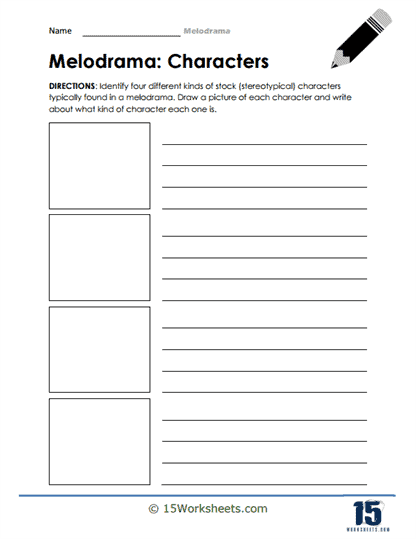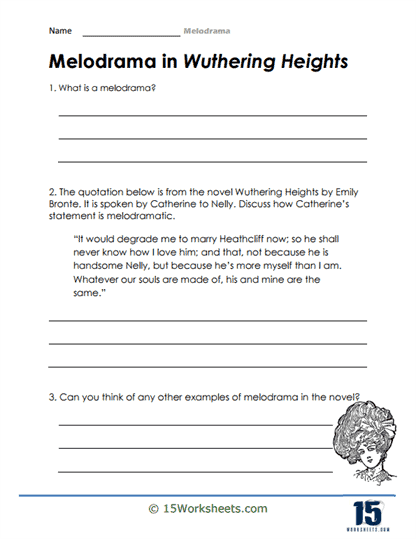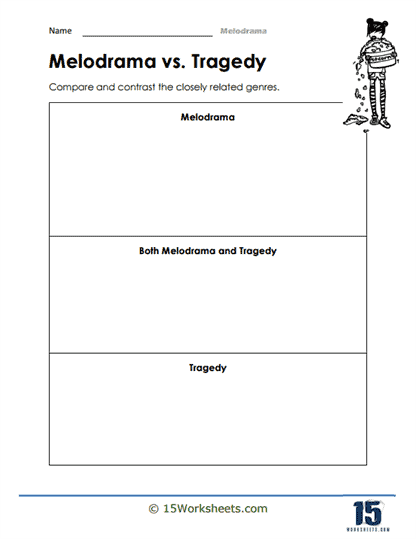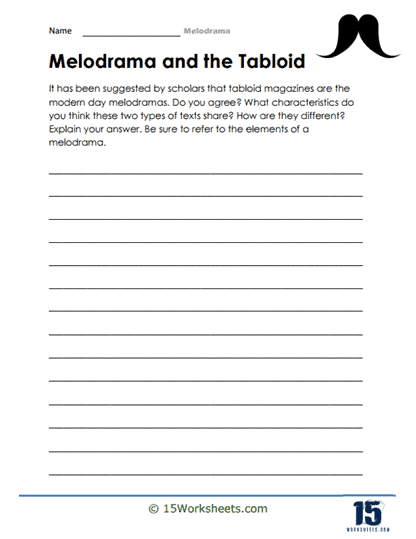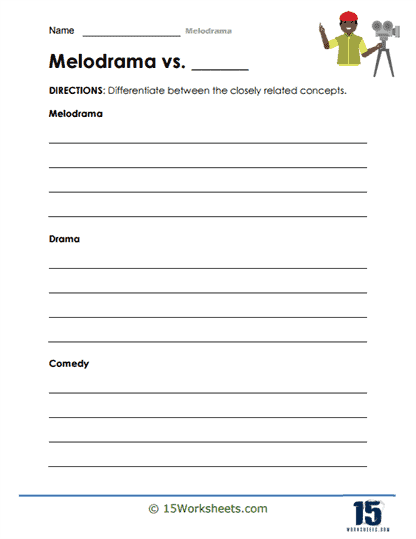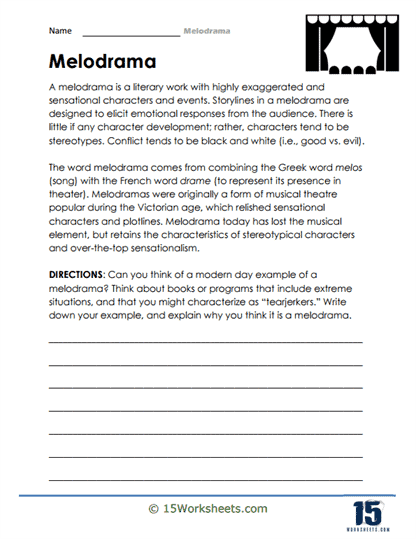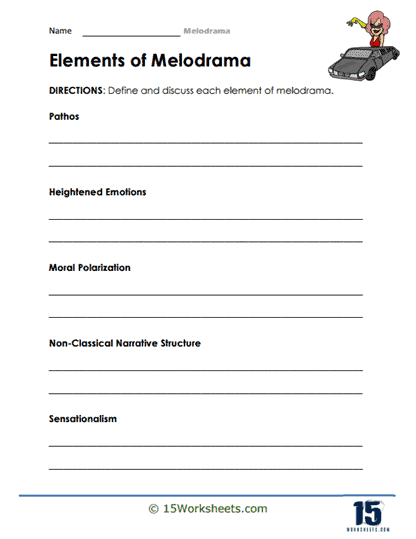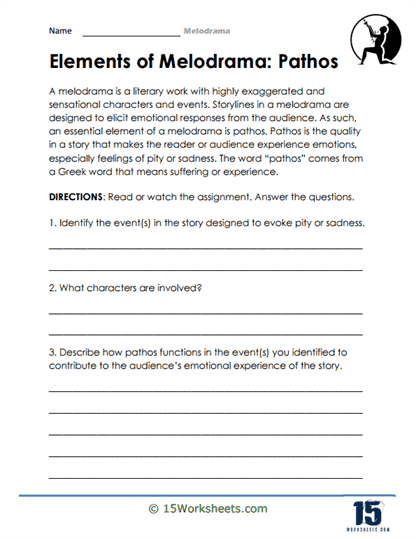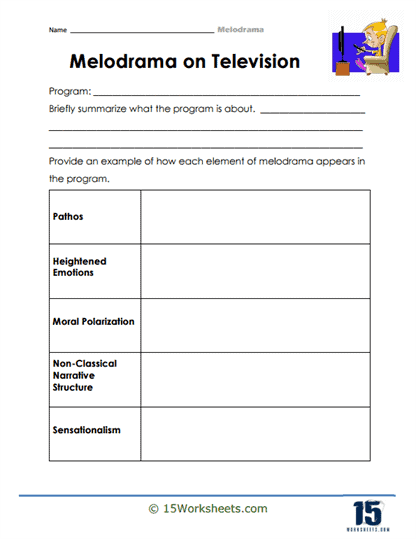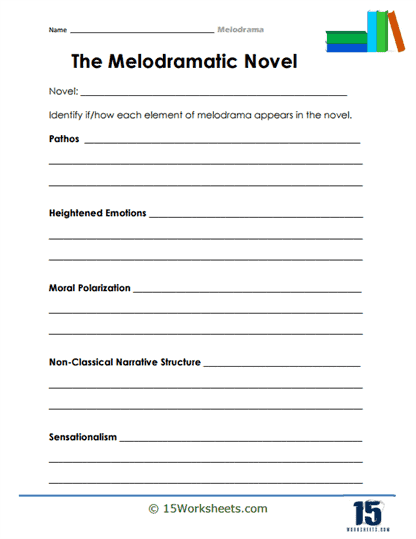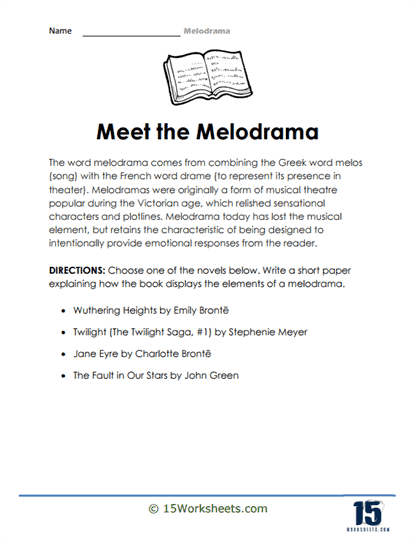Melodrama Worksheets
About These 15 Worksheets
Melodrama worksheets serve as valuable tools for enhancing language arts and reading skills among students. These worksheets are designed to engage learners in activities that explore the elements of melodrama, a dramatic genre characterized by exaggerated emotions, sensational plots, and heightened theatricality. By actively participating in exercises tailored to melodrama, students can sharpen their understanding of language arts while improving their reading comprehension, critical thinking, and analytical skills.
Through a variety of exercises that explore the elements of melodrama, students develop a deeper understanding of literary concepts, improve their reading comprehension, critical thinking, and analytical skills, and expand their vocabulary while also fostering creativity, self-expression, and confidence. By actively engaging with melodramatic texts and participating in thought-provoking activities, students not only become better readers and writers but also gain a greater appreciation for the power and artistry of storytelling in the melodramatic genre.
Types of Exercises On These Worksheets
Character Analysis
Melodrama worksheets often include exercises focused on character analysis. Students are prompted to examine the traits, motivations, and relationships of characters within melodramatic texts. Through activities such as character profiles, students develop a deeper understanding of how character dynamics drive the plot forward in melodramatic narratives.
Plot Structure
Understanding the structure of melodramatic plots is crucial for comprehending the genre. Worksheets may feature exercises that break down the typical elements of melodramatic plots, including exposition, rising action, climax, and resolution. By analyzing the progression of events in melodramatic texts, students learn to identify key plot points and understand how they contribute to the overall dramatic effect.
Dialogue Analysis
Melodrama is known for its melodious and exaggerated dialogue. Worksheets often include exercises that require students to analyze dialogue excerpts from melodramatic texts. By examining the language, tone, and rhetorical devices used in melodramatic dialogue, students gain insight into how language shapes character interactions and conveys emotions in the genre.
Setting Exploration
The setting plays a significant role in setting the stage for melodramatic narratives. Worksheets may include exercises that prompt students to explore the settings depicted in melodramatic texts, paying attention to details such as time period, location, and atmosphere. By immersing themselves in the vividly described settings of melodrama, students enhance their visualization skills and deepen their understanding of the narrative context.
Theme Identification
Melodramatic texts often explore universal themes such as love, betrayal, redemption, and justice. Worksheets may feature exercises that encourage students to identify and analyze the underlying themes present in melodramatic works. Through thematic analysis, students gain insight into the deeper meanings and messages conveyed through melodramatic storytelling.
Literary Devices
Melodrama makes extensive use of literary devices to create dramatic impact. Worksheets may include exercises that focus on identifying and analyzing literary devices such as symbolism, irony, foreshadowing, and imagery in melodramatic texts. By deconstructing the use of literary devices in melodrama, students develop a deeper appreciation for the craft of storytelling and enhance their literary analysis skills.
Performance and Interpretation
Melodrama worksheets may also incorporate performance-based exercises, where students have the opportunity to act out scenes from melodramatic texts or create their own melodramatic performances. Through performance and interpretation, students not only engage with the text on a deeper level but also develop their public speaking, presentation, and improvisation skills.
The Benefits Of These Worksheets
Improved Reading Comprehension
Engaging with melodrama worksheets requires students to actively read and analyze melodramatic texts, leading to improved reading comprehension skills. By dissecting the elements of melodrama, students learn to extract meaning from complex texts and develop strategies for understanding and interpreting literary works.
Critical Thinking Development
Melodrama worksheets foster critical thinking skills by prompting students to analyze, evaluate, and interpret melodramatic texts from multiple perspectives. Through exercises that require them to examine character motivations, plot structures, and thematic elements, students learn to think critically about the underlying themes and messages conveyed in melodrama.
Enhanced Analytical Skills
By engaging in exercises that focus on literary devices, dialogue analysis, and thematic exploration, students sharpen their analytical skills and learn to deconstruct the components of melodramatic storytelling. This analytical approach encourages students to look beyond the surface of the text and uncover deeper layers of meaning, contributing to their overall skill development in literary analysis.
Vocabulary Expansion
Melodrama worksheets expose students to rich and diverse vocabulary used in melodramatic texts, helping to expand their lexicon and strengthen their language skills. Through encounters with melodramatic dialogue and descriptive language, students learn new words and phrases in context, enhancing their ability to express themselves effectively in writing and speech.
Creativity and Expression
Performance-based exercises featured in melodrama worksheets provide students with opportunities to express themselves creatively and explore their dramatic talents. By acting out scenes from melodramatic texts or creating their own melodramatic performances, students cultivate their imagination, confidence, and self-expression, while also honing their communication and presentation skills.
What is the Literary Device of Melodrama?
Melodrama is a prominent literary device characterized by exaggerated emotions, sensational plots, and heightened theatricality. Authors utilize melodrama to evoke intense emotional responses from readers, heighten suspense, and emphasize moral themes. This essay will delve into the defining features of melodrama, its characteristics, provide examples from literature, and analyze its effects on readers.
Melodrama is a form of dramatic expression that amplifies emotions and situations to an extreme degree, often featuring clear-cut heroes and villains, intense conflicts, and moral dilemmas. Authors employ melodrama to engage readers’ emotions, create tension, and convey moral messages effectively. The hallmark of melodrama lies in its penchant for exaggeration and theatricality, aiming to elicit strong emotional reactions from the audience.
Characteristics of Melodrama
Exaggerated Emotions – Melodramatic literature often features characters expressing emotions in an exaggerated manner, such as intense love, hatred, fear, or despair.
Sensational Plots – Melodramas typically revolve around sensational plots filled with dramatic twists, conflicts, and high-stakes situations designed to captivate and engage the audience.
Moral Dichotomy – Melodramas often present a clear dichotomy between good and evil, with characters embodying virtuous or villainous qualities to emphasize moral themes.
Simplified Characters – Characters in melodrama tend to be portrayed in simplistic terms, with clear-cut motivations and behaviors that align with their moral alignment.
Theatricality – Melodramas are characterized by their theatricality, featuring dramatic dialogue, grand gestures, and heightened imagery to enhance the emotional impact of the narrative.
Examples of Melodrama in Literature
“Wuthering Heights” by Emily Brontë
In “Wuthering Heights,” the tumultuous love story between Catherine Earnshaw and Heathcliff exemplifies melodramatic elements. The intense passion between the protagonists, coupled with their tragic circumstances and societal constraints, creates a melodramatic narrative. Heathcliff’s brooding demeanor, Catherine’s conflicted emotions, and the novel’s gothic atmosphere contribute to its melodramatic tone. The novel’s portrayal of love, revenge, and redemption through exaggerated emotions and dramatic plot twists exemplifies the use of melodrama to evoke strong emotional responses from readers.
“Les Misérables” by Victor Hugo
Victor Hugo’s “Les Misérables” is another example of melodrama, featuring a sweeping narrative filled with themes of justice, redemption, and sacrifice. The novel’s protagonist, Jean Valjean, embodies the virtuous hero archetype, while the antagonist, Inspector Javert, represents the forces of law and order. The melodramatic conflict between good and evil, as well as the characters’ dramatic struggles and moral dilemmas, captivate readers’ emotions and underscore the novel’s overarching themes. Hugo’s use of vivid imagery, impassioned rhetoric, and larger-than-life characters contributes to the melodramatic intensity of the narrative.
“The Count of Monte Cristo” by Alexandre Dumas
Alexandre Dumas’s “The Count of Monte Cristo” is a classic example of melodrama, featuring a tale of betrayal, revenge, and redemption. The protagonist, Edmond Dantès, undergoes a dramatic transformation from a wrongfully imprisoned sailor to a vengeful and cunning aristocrat seeking retribution against those who wronged him. The novel’s intricate plot, filled with secret identities, betrayals, and dramatic confrontations, exemplifies the melodramatic genre. Dumas’s vivid storytelling, larger-than-life characters, and emotionally charged narrative elements resonate with readers, drawing them into the world of melodramatic intrigue and moral complexity.
Effects of Melodrama on Readers
Melodrama elicits a range of emotional responses from readers, including empathy, excitement, and catharsis. By exaggerating emotions and situations, melodrama intensifies the reader’s emotional engagement with the narrative, fostering a heightened sense of suspense and anticipation. The clear-cut moral dichotomy of melodrama allows readers to easily identify with characters and their struggles, making the narrative more accessible and compelling. Additionally, melodrama’s emphasis on themes of love, justice, and redemption resonates with readers’ universal desires for justice and moral clarity, reinforcing the emotional impact of the narrative. Overall, melodrama’s ability to evoke intense emotions and convey moral messages effectively makes it a powerful literary device that captivates and enthralls readers.



